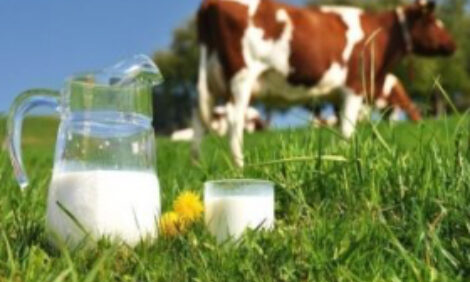



How Do I Get Started in Dairy Beef?
With decreased crop profits and dairy profits, both dairy and grain farmers are looking for ways to increase income by sending feed stuffs off the farm on the hoof instead of in a hopper or tanker, writes Jason Hartschuh with The Ohio State University Extension.
Many are questioning if one way to do this may be through raising their own dairy beef or purchasing dairy calves to feed out.
Considerations for getting started in dairy beef are:
- What age of calves will you be starting with - 24 hr, 8 weeks, or 700 lb?
- Do you have barns adequately designed for the age of calves you will be raising?
- Are you ready for a 12 to16 month commitment?
- What feeding program will you use?
There are three primary age groups for which you may choose to purchase dairy beef calves:
- Milk-fed calves less than 8 weeks of age calf weights should double between birth and weaning with an average daily gain (ADG) of 1.55 lb.
- Weaned calves, 350 to 700 lb, 4 to 6 months old; ADG goal: forage diet - 2 lb, high grain - 3 lb
- Feedlot ready calves, 700+ lb; ADG goal of 2.75 to 3 lb
Milk-Fed Calves
The health of calves starts in the first hours of a calf’s life. For this reason, it is recommended that you form a relationship with the farm that your calves will be coming from instead of buying calves that have been stressed and exposed through a stock yard. If you need help locating potential dairy farms from which to purchase calves, check with your local veterinarian and Extension Agricultural Educator. Calves need to have received 3 to 4 quarts of high quality colostrum within the first 6 hours of life to keep it healthy during the first 8 weeks of life. Calves also need to have their navels dipped and receive any supplemental vitamins and vaccines they may need as advised by the veterinarian. This group of calves will be the most labor intensive of any group and will require special equipment. Calves will need the most individual attention at this time. Dairy calves are typically on milk for the first 6 to 8 weeks of life, and many farms have now gone to an accelerated feeding program whereby increased milk is fed and calves are not weaned until 8 weeks of age. These calves tend to grow faster and stay healthier. These farms have gone to feeding calves 3 quarts of milk two or three times a day using a high protein/fat (28/20) milk replacer and a 22% protein starter grain. While some farms are feeding calves in group housing, this is reserved for the best managers of calf health. The best management practice for most farms is individual pens for each calf. Many farms choose to use plastic calf hutches because they can easily be washed and disinfected between each calf and ventilation is not a problem. When purchasing calves at this age, you will usually need to plan on dehorning and castrating them, which is not difficult but it takes some special facilities, training, and time to complete.
Weaned Calves
This group of calves is the second most labor intensive. Calves purchased in this age bracket should have already been dehorned and castrated, but male calves should be inspected for retained testicles. You should work with your veterinarian on a vaccination protocol, if you cannot find out a vaccination history, calves should generally be vaccinated for Bovine Respiratory Syncitial Virus (BRSV), Infectious Bovine Rhinotracheitis (IBR), and Bovine Viral Diarrhea (BVD). There are two primary feeding systems for consideration at this stage of growth. High energy feeding will lead to calves finishing between 12 to to 14 months. Low energy backgrounded calves are usually 15 to 17 months of age when finished. The difference between these two tracks is the amount of forages that are fed. The high energy fed calves will be on a high corn, low forage diet the entire time. The advantage to this system is that calves finish faster and on a smaller frame. This can allow you to move more animals to market with limited barn space. Feed costs are higher with this system, and the risk for acidosis is higher. A low energy system can be a good way to cheaply feed the calves for increased frame growth without putting on a lot of finish. If you are a middle operator and will not be finishing the calves, this may be the best system for you.
Feedlot Ready Calves
Calves at 600 to 800 lb are considered to be feedlot-ready calves. There are a lot of feeding options for these calves as well, but careful consideration is needed to choose the option best suited to your operation. Free choice feeding of shelled corn and a protein/mineral supplement through a self feeding system has been common for decades because this system requires less daily attention; however, they tend to have lower feed efficiency, decreasing profitability. A total mixed ration (TMR) tends to have better feed efficiency, especially when it is delivered to the bunk twice per day, although once daily can work. With this system, a slick bunk where the steers nearly run out of feed just before more arrives will be the ideal management goal. Precise quantities of feed delivered on time at every feeding are critical. The exact ration that will be most economical will vary based on byproducts and grains available in your area and yearly variations in prices. Sometimes a whole shelled corn diet blended with a protein pellet may be the most economical. For others, some form of multiple ground ingredients may be the best economical choice.
Facilities
In order to keep calves healthy, they need to have adequate ventilation and space. The recommended space allowances pre calf for bedded packs including the feeding area are: calves 4 to 8 months — 40 ft2, 8 to 12 months — 50 ft2, and 12 months to finish — 60 ft2 (Penn State University, Plans for Claves and Heifers). When animals have a separate feeding and resting area, these requirements decrease to 28 ft2 from 3 to 12 months and 32 ft2 from 12 months and beyond. This spacing assumes a 10 ft scrape alley for feeding with 12 inches of eating space per animal from 3 to 8 months, 15 inches from 9 to 12 months, and 18 inches for 12 months to finishing (Midwest Plan Services, Ames, IA). These bedded pack areas are for well ventilated barns; if your barns are not well ventilated, these areas will need to be increased so that pens stay dry. Beyond dry pens, air quality is a major concern to decrease the number of animals with clinical or sub-clinical pneumonia. Ideally, barns will have curtains that allow you to open the barn up for natural ventilation and close to prevent drafts in the winter. In order to monitor air quality, place your own nose about one foot above the bedded pack. If you smell ammonia, there are too many animals in the barn for the air movement. You will also need to be able to easily load fat cattle onto a trailer without stressing them. If your barn is not currently set up with a load-out chute and cattle-handling system, you may need to plan to build one.
12 to 16 Month Commitment
The average age of Holstein steers at marketing is 12 to 14 months of age. Many producers aim to market at 12 months of age, while a few others aim for a little higher age, up to 16 months, utilizing a higher forage diet. Feeding cattle will tie up income from your commodities for at least a year, thus you will need to consider your cash flow to determine if you can manage to incur expenses for a year. If not, you will need to have a discussion with your banker about the cash flow while you are starting up and options for operating loans.
Feeding Program Selection
There are two primary types of feeding programs that are utilized and selected based on the producer’s preferences and availability of feed processing equipment. Moderate energy, middle diets followed by high-energy finishing diets are utilized by producers who can store and utilize forage effectively and have a slightly longer feed out time. This set of diets may be more economical but not always. Building costs tend to be higher, since fewer animal units go through a barn in a year’s time. This system also grows larger animals that may have a marketing discount for too large of loins and a lower number of high choice cattle.
The other diet system is a single stage, high energy diet with mostly concentrates and low amounts of forage (10 to 15%) from about 350 lb to finishing weight. This system works very well for many producers who want to feed the same diet and don’t have a way to mix forage and concentrate to make a TMR. This diet system tends to have lower building costs, but it requires more cattle management to avoid acidosis problems.
Working with a nutritionist and veterinarian as you get started will be important for developing a feeding system to optimize animal growth and enterprise profitability and developing animal health protocols for optimal animal health.


